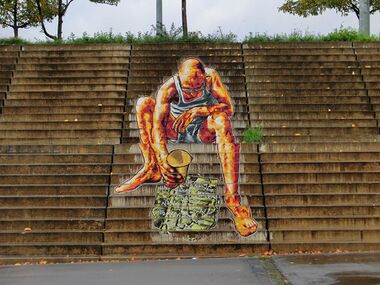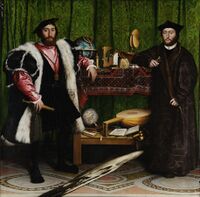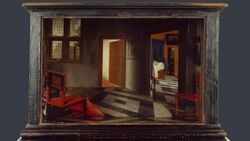Physics:Accidental viewpoint
An accidental viewpoint (i.e. eccentric or fixed viewpoint) is a singular position from which an image can be perceived, creating either an ambiguous image or an illusion. The image perceived at this angle is viewpoint-specific, meaning it cannot be perceived at any other position, known as generic or non-accidental viewpoints. These view-specific angles are involved in object recognition.[1] In its uses in art and other visual illusions, the accidental viewpoint creates the perception of depth often on a two-dimensional surface[2] with the assistance of monocular cues.
Object recognition
According to the recognition-by-components theory, object recognition is viewpoint-invariant. However, viewpoint specific angles are a necessity in object recognition when identifiable features cannot be viewed from all angles.[1] Object recognition is more accurate when identifying similarities between objects that are moving compared to objects that are static. In this case, viewing an object from an accidental viewpoint can result in altered perception in relation to mental prototypes.[3] When viewing an object from an accidental viewpoint scene consistency is more critical for object recognition than when viewing that object from a non-accidental viewpoint,[4] so in some cases viewing an object from its accidental viewpoint actually makes it harder to recognize the object, but we counteract that difficulty using contextual inference.
Controversy
2D symmetry was once thought to be able to facilitate 3D object recognition under accidental viewpoints. Some psychologists have proposed that the accidental viewpoints of 3D objects often involves the 2D symmetrical images that may not be perceived in the 3D objects.[5] However, researches showed that 2D symmetry will not help object matching in accidental viewpoints,[6] and others have argued that accidental viewpoints with 2D symmetry will even hinder 3D object matching and object recognition.[7] Results from face recognition study also agrees on the negative effect of symmetric face from accidental views.[8]
Art
Accidental viewpoint contributes to the successful perception of anamorphic images, which intentionally appear distorted from non-accidental viewpoints. Other than viewing the image from a specific location, the distortion can be countered by looking at the image when reflected in a mirror (known as catoptric anamorphoses[9]). How our brains interpret images make it so that the geometry of 2D object is related to that of 3D objects, rather than just taking the image for how it is, a drawing made from a single viewpoint.[2] Related to this is the generic viewpoint assumption, which is the tendency to assume that image characteristics are not a result of an accidental viewpoint.[10] The artist and mathematician Niceron developed a method of creating perspective anamorphic images by segmenting an image into a grid then distorting each segment of the grid from a square shape to a trapezoidal shape. The image can then be reconciled by viewing it from a specific point.[9] Two dimensional art objects generally use the assumption of a single viewpoint to give the illusion of depth (monocular depth cues), Hans Holbein's The Ambassadors (1533) is no different in that sense, however, Holbein also includes an anamorphic image of a skull which has a completely different view point in order to accurately view the object. In the 17th century, perspective boxes (peep boxes, raree shows) became popular attractions. These took advantage of the accidental viewpoint by creating a scene that appeared to be three dimensional when viewed through a single hole in the box. A modern representation of anamorphic images that makes use of an accidental viewpoint can be found in illusionistic street art.[9]
Psychological illusion
Psychologists have exploited the assumption of the generic viewpoint by using an accidental viewpoint to trick the brain into perceiving a scene that is realistically impossible. One famous example of this is the Ames room which uses distortion to create the image of a room that looks regular from an accidental viewpoint. When people interact with the room they appear to be changing size. The accidental viewpoint can also be used to trick Gestalt principles such that a curved line can appear straight when viewed from an accidental viewpoint.[11] The accidental viewpoint it also used when creating possible versions of impossible object illusions.[2]
References
- ↑ 1.0 1.1 Wilson, Kevin D; Farah, Martha J (May 2003). "When does the visual system use viewpoint-invariant representations during recognition?" (in en). Cognitive Brain Research 16 (3): 399–415. doi:10.1016/S0926-6410(03)00054-5. PMID 12706220.
- ↑ 2.0 2.1 2.2 Sánchez-Reyes, Javier; Chacón, Jesús M. (March 2020). "How to make impossible objects possible: Anamorphic deformation of textured NURBS" (in en). Computer Aided Geometric Design 78: 101826. doi:10.1016/j.cagd.2020.101826.
- ↑ Vuong, Quoc C; Friedman, Alinda; Plante, Courtney (January 2009). "Modulation of Viewpoint Effects in Object Recognition by Shape and Motion Cues" (in en-US). Perception 38 (11): 1628–1648. doi:10.1068/p6430. ISSN 0301-0066. PMID 20120262.
- ↑ Sastyin, Gergo; Niimi, Ryosuke; Yokosawa, Kazuhiko (April 2015). "Does object view influence the scene consistency effect?" (in en). Attention, Perception, & Psychophysics 77 (3): 856–866. doi:10.3758/s13414-014-0817-x. ISSN 1943-3921. PMID 25522833.
- ↑ Lawson, Rebecca; Humphreys, Glyn W. (September 1998). "View-specific effects of depth rotation and foreshortening on the initial recognition and priming of familiar objects". Perception & Psychophysics 60 (6): 1052–1066. doi:10.3758/bf03211939. ISSN 0031-5117. PMID 9718963.
- ↑ Koning, Arno; van Lier, Rob (2006-01-01). "No symmetry advantage when object matching involves accidental viewpoints" (in en). Psychological Research 70 (1): 52–58. doi:10.1007/s00426-004-0191-8. ISSN 1430-2772. PMID 15480756.
- ↑ Poggio, Tomaso; Vetter, Thomas (1994). "Symmetric 3D objects are an easy case for 2D object recognition". Spatial Vision 8 (4): 443–453. doi:10.1163/156856894x00107. ISSN 0169-1015. PMID 7772550.
- ↑ Troje, Nikolaus F.; Bülthoff, Heinrich H. (June 1996). "Face recognition under varying poses: The role of texture and shape". Vision Research 36 (12): 1761–1771. doi:10.1016/0042-6989(95)00230-8. ISSN 0042-6989. PMID 8759445.
- ↑ 9.0 9.1 9.2 Di Lazzaro, Paolo; Murra, Daniele; Vitelli, Pietro (22 November 2019). "The interdisciplinary nature of anamorphic images in a journey through art, history and geometry" (in en). Journal of Mathematics and the Arts 13 (4): 353–368. doi:10.1080/17513472.2018.1506627. ISSN 1751-3472.
- ↑ Albert, Marc K (May 2000). "The Generic Viewpoint Assumption and Bayesian Inference" (in en-US). Perception 29 (5): 601–608. doi:10.1068/p3050. ISSN 0301-0066. PMID 10992956.
- ↑ Helm, Peter A. van der (17 December 2015). Simplicity in vision : a multidisciplinary account of perceptual organization. Cambridge University Press. pp. 59. ISBN 978-1-316-50283-9. OCLC 1062308318. https://books.google.com/books?id=Z7dEAgAAQBAJ.
 |





